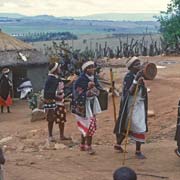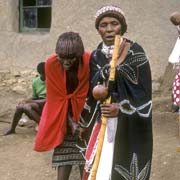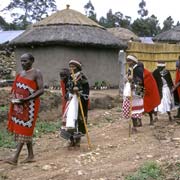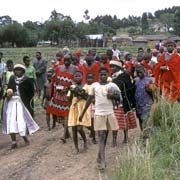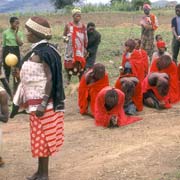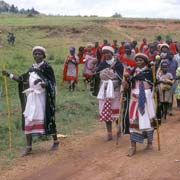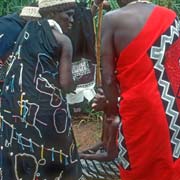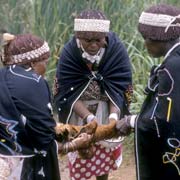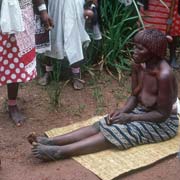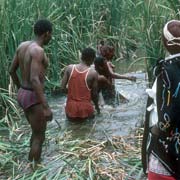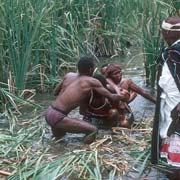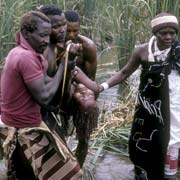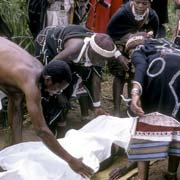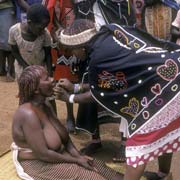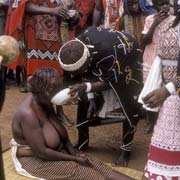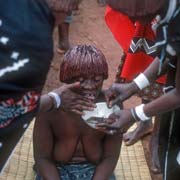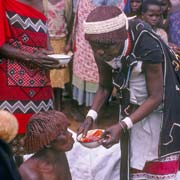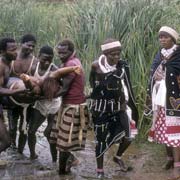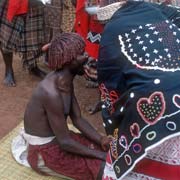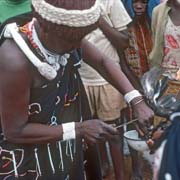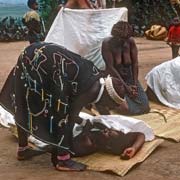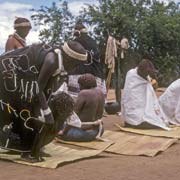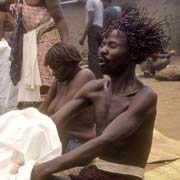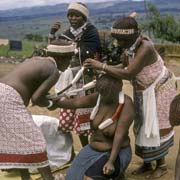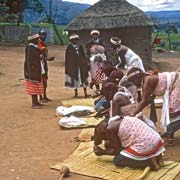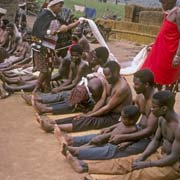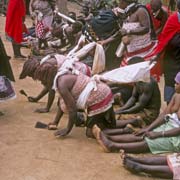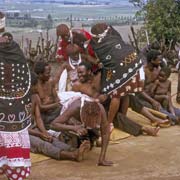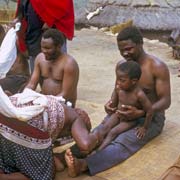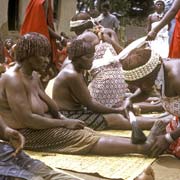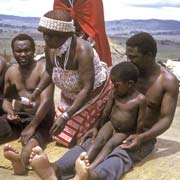Photos of an iNtfwasa graduation Ceremony in 1972 - Day 2, Swaziland
An iNtfwasa graduation Ceremony in 1972 - Day 2
After Day 1, early the following morning the candidate tangoma walked to the river by themselves, with the remains of the goats that had been killed for them the previous day. Later on the people had assembled at one side of the plaza and the drums were pounding out again the rhythm of the "emadloti" or ancestral spirits.
you may then send it as a postcard if you wish.
The candidates, led by one of the senior tangoma, marched onto the ground, to a different marching rhythm; then the "emadloti" rhythm took over again and the candidates were then draped in red cloth. The rhythm of the drums changed again: this was the rhythm of the emaNdzawe (or Ndau, a people living in Mozambique and Zimbabwe): long ago, a group of Swazis, marauding in the area had come across some cattle belonging to those emaNdzawe; they had been told not to kill those as these cows were reserved to be offered to the ancestral spirits. The Swazi ignored this, killed the cattle and also killed those people daring to oppose them. Since that time the emaNdzawe spirits have haunted them and they need to be placated in these ceremonies. Preceded by men, carrying bowls and girls carrying live chickens, they were led out of the village towards the river. Drums pounding, they stopped from time to time, the candidates shivering with folded hands and moving to the rhythm of the drums.
Having arrived at the river, the candidates, one by one, had to sit down on a mat. LaMabuza, their teacher, first scraped their tongue with a large knife; she then made a small incision in their tongue with a razor blade and rubbed powdered "umutsi", traditional medicine in the cut, "to make sure they would always tell the truth when they dealt with their patients". The head of a chicken was cut off with the knife and its blood allowed to flow into a small bowl. The chicken was then flung into the river, where it was quickly gathered: it would be cooked that evening. The candidate had to drink a little of the blood and the bowl was then given to the young girl who had been carrying the chicken: she too had to take a little bit of the blood. The candidate was then led into the water, where two or three men pushed her under three times. She then "died" and was carried out of the water, laid on a mat and covered with a white sheet. It was really believed the sangoma died: she died as an ordinary human being. After all candidates had undergone this ritual, they were transported back to the village (in this case on the back of a truck) where they would be "revived" again.
Back in the village, to the unceasing pounding of the drums beating out the "emaNdzawe" rhythm, one of the "bogobela" or senior tangoma lifted the sheet and lightly brushed the "dead" sangoma under the nose with a "sizinga", a special brush, that would bring them back to life again. One by one they shot bolt upright after they had been brushed, swung around on their knees and, hands clasped together, shook up and down to the rhythm of the drums: they had been reborn as fully qualified "tangoma" or diviners. The new tangoma were helped into an "umfembi", a device draped around their upper body. This would help them to "smell out" bad sprits that might have entered the bodies of their patients. They then performed a "kufemba" ritual in which they carried a "sizinga", a brush that contained, like the "umfembi", magical ingredients; the most important of that is the nose of a hyena: a hyena has a very keen sense of smell and this would help the sangoma to smell out that spirit body.
One by one they were guided past a row of people, sitting on the ground on mats. The sangoma crawled on hands and knees among them, brushing them all over, brushing herself under her nose and "sneezing the spirits out". When she found an evil spirit on one of those people, she physically attacked him or her; she would grab and wrestle him or her to the ground and even sit on the unfortunate patient. The sangoma, guiding her, tried to pull her off the patient and brush her under her nose so she could sneeze that spirit out, which would break the spell. She seemed to be in trance and could attack anyone, even small children. Most "patients" took this with good humour.
After this the new tangoma had to sit on a mat and one of the "bogobela" or senior tangoma performed this kufemba ritual on them as well. Bad spirits were smelled and sneezed out, so the newly qualified tangoma were "clean" and ready to start life as a fully qualified sangoma.
See also: iNtfwasa Ceremony - 1973, Video iNtfwasa Ceremony, 1973 - Day 1 and Day 2, and an explanation of the sangoma ceremonies.





